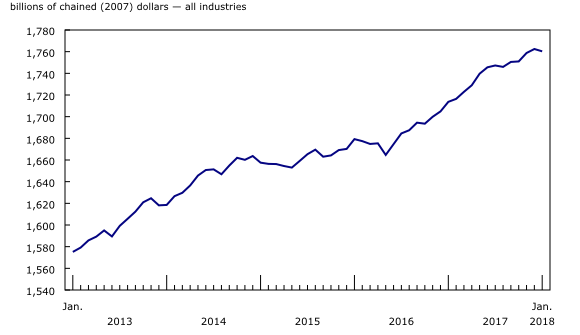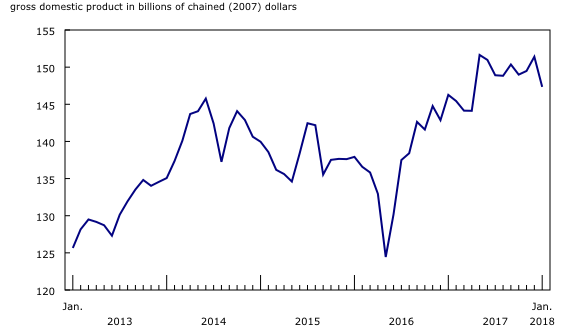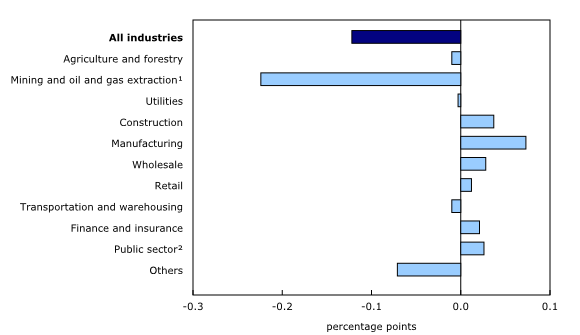Gross domestic product by industry, January 2018
Archived Content
Information identified as archived is provided for reference, research or recordkeeping purposes. It is not subject to the Government of Canada Web Standards and has not been altered or updated since it was archived. Please "contact us" to request a format other than those available.
Released: 2018-03-29
January 2018
-0.1% 
(monthly change)
Real gross domestic product edged down 0.1% in January, offsetting part of the 0.2% growth in December. The decline was mainly the result of lower output of non-conventional oil extraction and decreased activity in real estate. The 20 industrial sectors were evenly split between increases and decreases.
The output of goods-producing industries fell 0.4% in January, mainly on lower non-conventional oil extraction. There were increases in the manufacturing and construction sectors.
The output of services-producing industries was essentially unchanged in January, as a decline in real estate and rental and leasing was offset by increases in the wholesale, retail, and finance and insurance sectors. This was the weakest monthly growth for services-producing industries in more than a year.
The largest decline in mining, quarrying, and oil and gas extraction since May 2016
Following two months of growth, mining, quarrying, and oil and gas extraction declined 2.7% in January, its largest decline since May 2016.
Oil and gas extraction declined 3.6% in January following two months of growth. Unscheduled maintenance shutdowns at some facilities contributed to a 7.1% drop in non-conventional oil extraction. Conventional oil and gas extraction was down for the third consecutive month, contracting 0.5% on lower crude petroleum and natural gas extraction.
Mining excluding oil and gas extraction was down for the fourth month in a row, declining 0.8% in January. Metal ore mining declined 2.2%, as all industries were down with the exception of other metal ore mining. Non-metallic mineral mining was up 0.9% following four months of decline, as growth in all other industries more than offset a 1.6% decline in potash mining. Coal mining was up 0.6%.
After eight monthly declines, support activities for mining and oil and gas extraction grew 2.5% as a result of an increase in rigging services.
Real estate and rental and leasing declines in January
Real estate and rental and leasing declined 0.5% in January following six consecutive months of growth.
The output of offices of real estate agents and brokers fell 12.8% in January, its largest monthly decline since November 2008. This more than offset the increases of the previous five months. Home resale activity was down in most Canadian markets, as new mortgage lending rules, including stress-testing for uninsured mortgages, announced in October 2017 took effect in January 2018.
Lower activity in real estate contributed to the professional, scientific and technical services sector edging down 0.1% as legal, accounting and related services contracted 1.9%.
Manufacturing resumes growth following December decline
Manufacturing was up 0.7% in January, the third increase in four months after having declined in December. The January gain came from a 1.6% increase in non-durable manufacturing, while durable manufacturing was essentially unchanged.
The growth in non-durable manufacturing was mainly the result of a 4.3% rise in the chemical manufacturing subsector. There were increases in the output of the pharmaceutical and medicine (+10.1%), pesticide, fertilizer and other agricultural chemical (+12.0%) and resin, synthetic rubber, and artificial and synthetic fibres and filaments manufacturing (+3.5%) industries. Food (+1.2%) and beverage and tobacco manufacturing (+5.0%) were also up, while petroleum and coal products manufacturing (-0.6%) declined for a third consecutive month.
Durable manufacturing was essentially unchanged in January, after decreasing 0.2% in December, as 4 of 10 subsectors contracted in January. There were declines in wood products (-4.0%), machinery (-1.9%) and non-metallic mineral products manufacturing (-5.0%), while fabricated metals (+2.6%), miscellaneous (+7.6%) and computer and electronic products manufacturing (+4.2%) increased. Transportation equipment declined for the third time in four months, contracting 0.7% in January as motor vehicle manufacturing was down 6.5% on account of atypical shutdowns at some assembly plants.
Wholesale and retail trade up
Wholesale trade was up 0.5% in January as six of nine subsectors grew, more than offsetting the decline in December. Machinery, equipment and supplies (+3.0%) led the growth, mainly on the strength of the other machinery, equipment and supplies industry. Food, beverage and tobacco wholesaling was up 2.8% as food and beverage products wholesaling increased. Offsetting some of the growth was a 3.7% decline in building material and supplies wholesaling. Farm products wholesaling declined 5.7% as activity at oilseeds and grain dealers contracted.
Retail trade was up 0.2% with its 12 subsectors evenly split between increases and decreases. Retailers that posted the largest increases in activity in January, such as general merchandise (+2.1%), clothing and clothing accessories (+2.1%) and electronics and appliance stores (+4.0%), had registered declines in December. Activity in building material and garden equipment and supplies stores (-1.8%) declined for the third consecutive month. Activity in gasoline stations fell 1.7% after three months of increases. Motor vehicle and parts dealers' output was down 0.7% as activity at new and used car dealers contracted.
Construction increases
Activity in the construction sector was up 0.5% in January, with increases in the majority of subsectors. Residential construction rose 0.9%, as double, row and apartment-type dwellings construction grew along with home alterations and improvements. Non-residential construction was up 0.6%, rising for the eighth month in a row, led by industrial, public and commercial construction.
With a 0.9% gain in January, repair construction continued its sequence of alternating increases and declines since the second half of 2017. Engineering and other construction activities edged down 0.1%.
Other industries
Transportation and warehousing contracted 0.2% in January after two months of growth, as five of nine subsectors declined. This contraction mainly reflected a 3.2% decline in rail transportation, as rail movement of petroleum and chemicals, metals and minerals and forest products declined. Pipeline transportation declined 0.5%, as the 3.4% growth in pipeline transportation of natural gas was more than offset by a 4.3% decline in crude oil and other pipeline transportation. There was increased activity from urban transit systems and air transportation.
The finance and insurance sector grew 0.3% in January. Financial investment services, funds and other financial vehicles were up 1.2%, as financial market activity increased. Insurance carriers and related activities grew 0.6%, while depository credit intermediation and monetary authorities were essentially unchanged.
The public sector edged up 0.1% in January, as education and healthcare and social assistance increased, while public administration edged down.
Utilities edged down 0.1% as electric power generation, transmission and distribution declined 0.2%, while natural gas distribution rose 0.2%.
Accommodation and food services edged up 0.1%. Accommodation services grew 0.5%. Food services and drinking places were essentially unchanged.
Agriculture, forestry, fishing and hunting decreased 0.7% in January, the fifth decline in six months.
Sustainable Development Goals
On January 1, 2016, the world officially began implementation of the 2030 Agenda for Sustainable Development—the United Nations' transformative plan of action that addresses urgent global challenges over the next 15 years. The plan is based on 17 specific sustainable development goals.
The release on gross domestic product by industry is an example of how Statistics Canada supports the reporting on the Global Goals for Sustainable Development. This release will be used in helping to measure the following goal:

Note to readers
Monthly gross domestic product (GDP) by industry data at basic prices are chained volume estimates with 2007 as the reference year. This means that data for each industry and each aggregate are obtained from a chained volume index, multiplied by the industry's value added in 2007. Monthly data are benchmarked to annually chained Fisher volume indexes of GDP obtained from the constant-price supply and use tables (SUT) up to the latest SUT year (2014).
For the period starting with January 2015, data are derived by chaining a fixed-weight Laspeyres volume index to the prior period. The fixed weights are 2014 industry prices.
This approach makes the monthly GDP by industry data more comparable with expenditure-based GDP data, which are chained quarterly.
All data in this release are seasonally adjusted. For information on seasonal adjustment, see Seasonally adjusted data – Frequently asked questions.
For more information on GDP, see the video What is Gross Domestic Product (GDP)?
Revisions
With this release of monthly GDP by industry, revisions have been made back to January 2017.
Each month, newly available administrative and survey data from various industries in the economy are integrated and result in statistical revisions. Updated and revised administrative data (including taxation statistics), new information provided by respondents to industry surveys, and standard changes to seasonal adjustment calculations are incorporated with each release.
Real-time CANSIM tables
Real-time CANSIM table 379-8031 will be updated on April 16. For more information, consult the document Real-time CANSIM tables.
Next release
Data on GDP by industry for February will be released on May 1.
Products
For more information about monthly national gross domestic product by industry, see the System of Macroeconomic Accounts module on our website.
The User Guide: Canadian System of Macroeconomic Accounts (13-606-G) is also available.
The Methodological Guide: Canadian System of Macroeconomic Accounts (13-607-X) is also available.
Contact information
For more information, contact us (toll-free 1-800-263-1136; 514-283-8300; STATCAN.infostats-infostats.STATCAN@canada.ca).
To enquire about the concepts, methods or data quality of this release, contact Allan Tomas (613-790-6570), Industry Accounts Division.
- Date modified:




